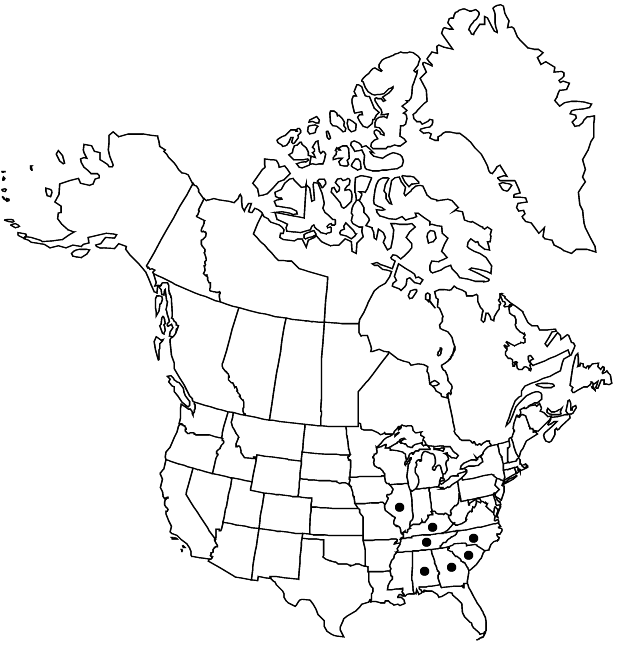Difference between revisions of "Lysimachia fraseri"
in A. P. de Candolle and A. L. P. P. de Candolle, Prodr. 8: 65. 1844 ,.
FNA>Volume Importer |
imported>Volume Importer |
||
| (4 intermediate revisions by 2 users not shown) | |||
| Line 1: | Line 1: | ||
{{Treatment/ID | {{Treatment/ID | ||
|accepted_name=Lysimachia fraseri | |accepted_name=Lysimachia fraseri | ||
| − | |accepted_authority=Duby | + | |accepted_authority=Duby |
|publications={{Treatment/Publication | |publications={{Treatment/Publication | ||
|title=in A. P. de Candolle and A. L. P. P. de Candolle, Prodr. | |title=in A. P. de Candolle and A. L. P. P. de Candolle, Prodr. | ||
| Line 7: | Line 7: | ||
}} | }} | ||
|common_names=Fraser’s loosestrife | |common_names=Fraser’s loosestrife | ||
| + | |special_status={{Treatment/ID/Special_status | ||
| + | |code=E | ||
| + | |label=Endemic | ||
| + | }}{{Treatment/ID/Special_status | ||
| + | |code=C | ||
| + | |label=Conservation concern | ||
| + | }} | ||
|basionyms= | |basionyms= | ||
|synonyms= | |synonyms= | ||
| Line 32: | Line 39: | ||
-->{{#Taxon: | -->{{#Taxon: | ||
name=Lysimachia fraseri | name=Lysimachia fraseri | ||
| − | + | |authority=Duby | |
| − | |authority=Duby | ||
|rank=species | |rank=species | ||
|parent rank=genus | |parent rank=genus | ||
| Line 46: | Line 52: | ||
|publication title=in A. P. de Candolle and A. L. P. P. de Candolle, Prodr. | |publication title=in A. P. de Candolle and A. L. P. P. de Candolle, Prodr. | ||
|publication year= | |publication year= | ||
| − | |special status= | + | |special status=Endemic;Conservation concern |
| − | |source xml=https:// | + | |source xml=https://bitbucket.org/aafc-mbb/fna-data-curation/src/2e0870ddd59836b60bcf96646a41e87ea5a5943a/coarse_grained_fna_xml/V8/V8_620.xml |
|genus=Lysimachia | |genus=Lysimachia | ||
|species=Lysimachia fraseri | |species=Lysimachia fraseri | ||
Latest revision as of 22:44, 5 November 2020
Stems erect, sparingly branched, 1–1.5(–20) dm, stipitate-glandular, especially distally; rhizomes slender or slightly thickened; bulblets absent. Leaves whorled to opposite distally; petiole 0.4–1.5 cm, eciliate; blade lanceolate to elliptic or oblanceolate, 6–15 × 2–6 cm, base rounded to cuneate, slightly decurrent, margins entire, slightly revolute or plane, eciliolate, apex acute, surfaces punctate at least abaxially, stipitate-glandular abaxially and, sometimes, adaxial veins sparsely pubescent; venation pinnate-arcuate. Inflorescences terminal, panicles, 6–25 cm. Pedicels 0.3–0.6 cm, stipitate-glandular. Flowers: sepals 5, calyx not streaked, 4–6 mm, stipitate-glandular at least marginally, lobes lanceolate, margins darkly thickened; petals 5, corolla yellow, not streaked, rotate to slightly campanulate, 6–11 mm, lobes with margins entire, apex acute to obtuse, finely and minutely stipitate-glandular; filaments connate 1.3–1.7 mm, shorter than corolla; staminodes absent. Capsules 3–5 mm, not punctate, glabrous.
Phenology: Flowering summer.
Habitat: Rich woods, open slopes
Elevation: 300-1500 m
Distribution

Ala., Ga., Ill., Ky., N.C., S.C., Tenn.
Discussion
Of conservation concern.
Selected References
None.